7 Best Thermal Imaging Cameras (Circuits 2024)
I believe everyone has used a camera for taking pictures and videos. But interestingly, there are cameras (called thermal cameras) that you can use to find out the temperature of your surroundings.
A thermal camera can tell the temperature (infrared radiation from the surface) of whatever its lens sees. This helps in many applications, such as home inspection, circuit inspection, building inspection, and so much more.
For the electronics circuit, you can see which component is getting heated more or which area of the circuit is more heated than the rest so that you can make informed decisions.
Similarly, for a home inspection, you can tell which wall has water pipes, which room is heated, what causes the heat, and so many other things.
Also, these cameras have applications for electrical circuits and electricians as well.
Now, if you are a new buyer, then making the purchase decision can be tricky. There are some parameters that you may not know that make a camera the best thermal imaging camera. And perhaps a lot more questions.
Well,
At the end of this article, you should be able to know:
- What are some best thermal imaging cameras for home and circuit inspection
- See the thermal cameras for your mobile phone
- What makes a thermal camera best, i.e., the technical parameters
- Some cheap thermal cameras out there in the market
- And more…
Sounds interesting? Then I am sure you will enjoy the rest of this article.
Let’s get started.
Best Thermal Imaging Cameras
Every surface radiates infrared radiation. We humans as well. But we can’t detect those radiations using our nacked eyes.
The amount of these radiations is directly in relation to the surface temperature. This means that the warmer the surface the higher will be infrared radiation.
There are so many thermal cameras available on the market. But…
The best thermal imagining cameras that I and field professionals recommend is either FLIR C5, or the Klein Tools TI250. They are the best because they come from proven brands. They are reliable, used by thousands of people, high quality, and have really affordable price tags.
Now, I choose the above and below list of top thermal cameras based on the following technical parameters.
Choosing the best thermal camera
Following are some of the technical parameters that one should look for when selecting a thermal camera.
Remember, each camera’s specifications are best for a specific situation. You can’t pick a camera and expect it to work in all possible cases and situations.
a. Form Factor
By form factor I mean what type of user you are and for what purpose do need a thermal camera. For example, for a casual home use case, or for a hobbyist, a phone thermal is the best and optimal choice.
Following is a phone thermal camera. You attach it to your phone and use the use phone screen for imaging and readings.
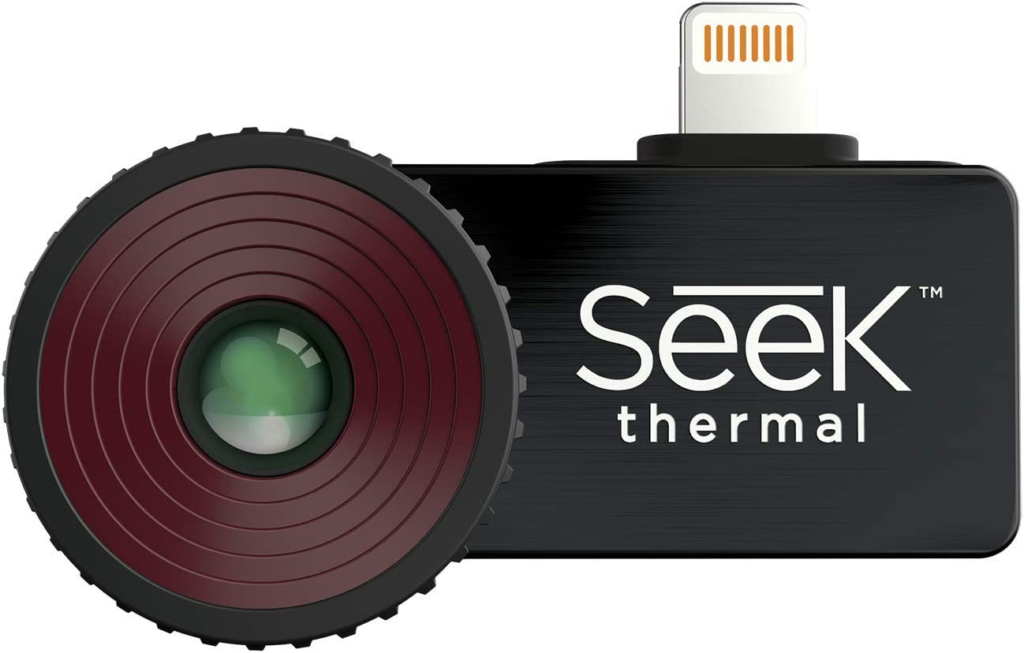
This type of camera comes for both IOS and Android.
The other type of camera is the standalone or compact thermal camera.
For an electrician and more professional work, a standalone thermal camera is the best option. You can use it for image taking and report making.
Following is a standalone thermal camera.
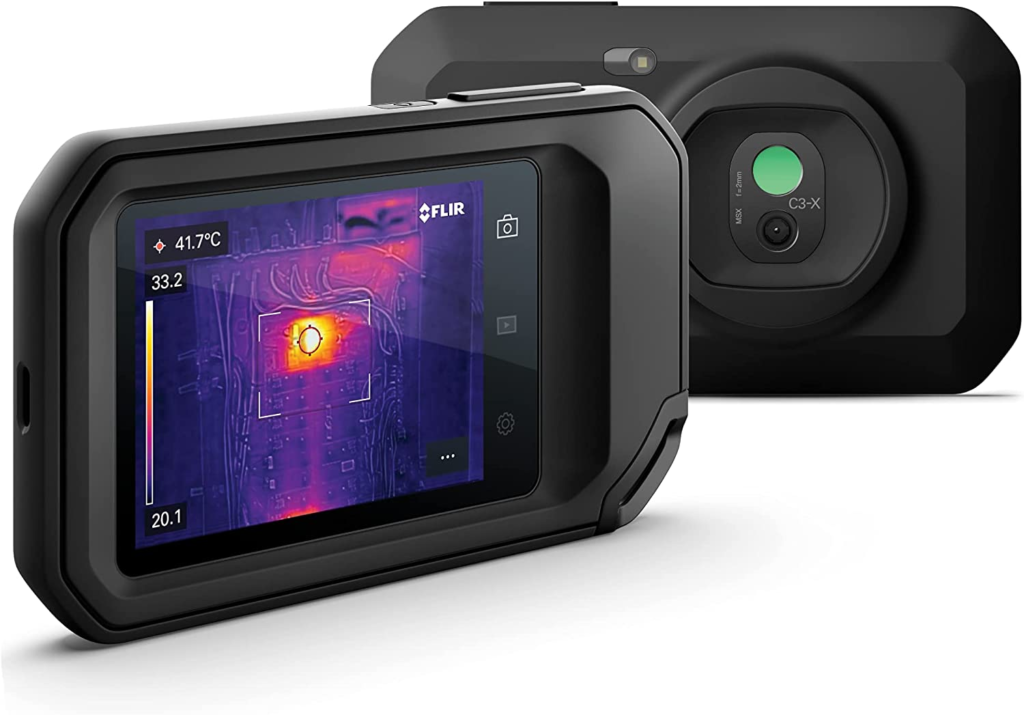
You can use it for circuit inspection as well.
b. Thermal Resolution
In simple words, it is the minimum detectable temperature difference. Like to which extent the camera can work accurately.
The minimum requirement is 80×60 pixels. The lower this number the less price tag the camera will have.
For good quality, the camera should have a thermal resolution of 160×120 pixels. Beyond this range, comes the pro level resolutions, i.e., 320×240 pixels.
Choose the thermal resolution based on what you want to do with the thermal camera. For high quality pictures, you need more thermal resolution. If you ask me, I would say go for 160×120. It is a standard one and covers all the major applications.
c. Sensitivity
You can define sensitivity as the smallest temperature variation a thermal camera can detect. It is measured in milli kelvins (mK). For example, 100mK sensitivity means that the camera can sense a 0.1 temperature difference.
For sensitivity, the smaller the number the better would be the thermal camera.
d. Temperature range
This means for what temperature ranges a thermal camera can give accurate information. Normally, a good thermal camera should be able to give you values in negative and positive both. So a typical range should be like -10 to 50 Degree Centigrade.
For home applications, a good range is 300–400 Degrees Fahrenheit. For pro and industrial applications, it should be up to 2400F.
e. Covering area
It is straightforward. It is the area that the IR lens in the camera can accurately cover. In simple words, the visible area that is seen through the IR camera lens. It is measured in degrees.
A standard area is between 20 and 35 degrees. This is suited for electrical inspection and home applications.
f. Refresh rate
It is the rate at which the camera updates the reading on the screen. It is frames per second. We measure this parameter in terms of frequency (Hertz).
If you are working with a still situation then 9Hertz is fine. It is slow and bad for moving applications. For moving applications, you should go for a high refresh rate.
The higher the refresh rate the better. But it will add cost to the price tag as well.
List of the best thermal imaging cameras
Alright!
Above were the parameter that I take into consideration for the below list. All the above things are applied to each and every model you will see below.
1. FLIR C5 Thermal Imaging Camera
The first best thermal imaging camera that I have for you is from the famous brand FLIR. This camera is a standalone camera with state of the art cloud connectivity option.

Important benefits:
- It has the standard resolution of 160×120 Pixels
- It is connected to clouds so that you can easily share the data for reporting purposes.
- It has the temperature range of -20 to 400ºC (-4 to 752ºf)
- Features a high-resolution thermal sensor that can detect temperature differences as small as 50 mK
- 3.5 inch (8.89 cm) touchscreen display with 640×480 display resolution
- Capable of capturing high-quality thermal images and videos
In a short summary, the FLIR C5 (Amazon link) is designed for professional use. It is an affordable inspection tool for electrical, mechanical, building, and maintenance applications.
2. Seek Thermal ShotPRO
The next best thermal imaging camera that I have for you is from the Seek Thermal brand. This brand is famous for making quality thermal cameras both standalone and mobile versions.
The model for this brand, the ShotPRO, is a compact and affordable thermal imaging camera that is designed for use in a wide range of applications.
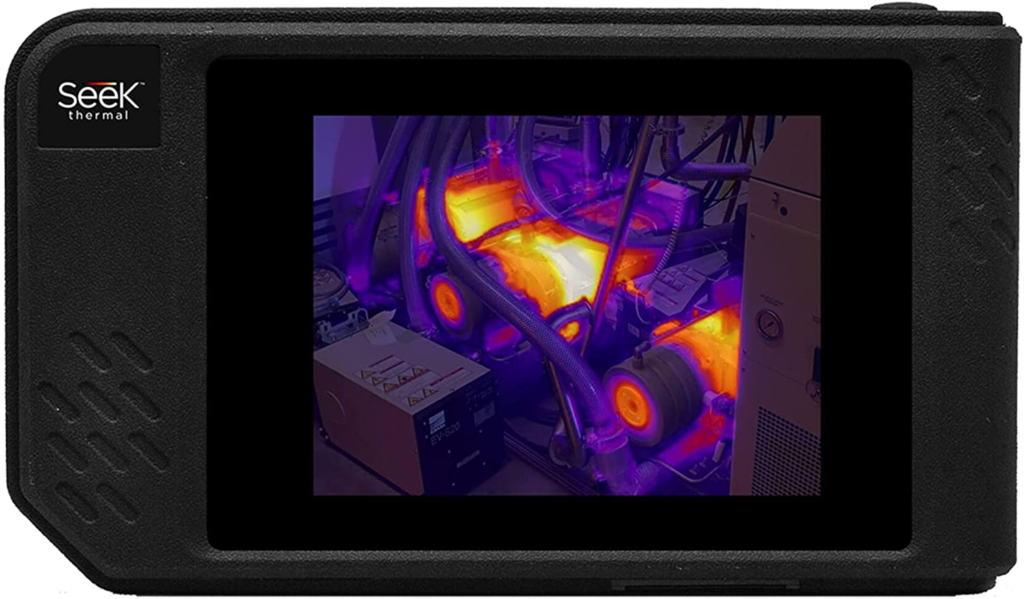
Important features:
- A pro level resolution of 320 × 240 with such a reasonable price tag
- You can identify, diagnose and report problems faster with its high resolution thermal images and video
- It comes with a large color touch screen so that you can all the details very clearly
- One thing to notice is its battery life. You can consistently use it for up to 4 hours. Which I think is very impressive.
- Temperature measurement range of -40 °C to 330 °C
In a short summary, the ShotPRO (Amazon link) is a great option for those looking for a compact and affordable thermal imaging camera. It provides detailed and accurate thermal images and is easy to use and portable.
3. Klein Tools TI250
The next camera is from Klein Tools, an American manufacturer of hand tools for more than 160 years. Klein Tools makes premium-quality, professional-grade tools that deliver performance, durability, and precision.
The camera from this brand is amazing and geared toward average budget customers. It is a high-performance thermal imaging camera that is designed for professional use.

Important features:
- It has a resolution of 10,000 pixels to troubleshoot hot and cold spots
- Comes with a rechargeable battery, which can be charged via a USB cable, avoiding the need for replacing batteries.
- For reporting, you can store and share images with an optional microSD card
- Temperature range of -4 to 752 degrees Fahrenheit (-40 to 250 degrees Celsius). Which is standard.
- Rugged design that can withstand heavy use in a variety of industrial and commercial settings.
In a short summary, the Klein Tools TI250 (Amazon link) is a versatile, powerful, and user-friendly tool for professionals working in electrical inspections, building diagnostics, HVAC/R, and many other applications.
4. HIKMICRO Thermal Imaging Camera
The next thermal camera is from the Hikmicro brand. It is a standalone camera with 8MP visual camera as well so that can compare and make an informed decision.
Taking about the brand, it is a leading thermal imaging equipment and solutions provider, specializing in SoC and MEMS design, development, and manufacturing.
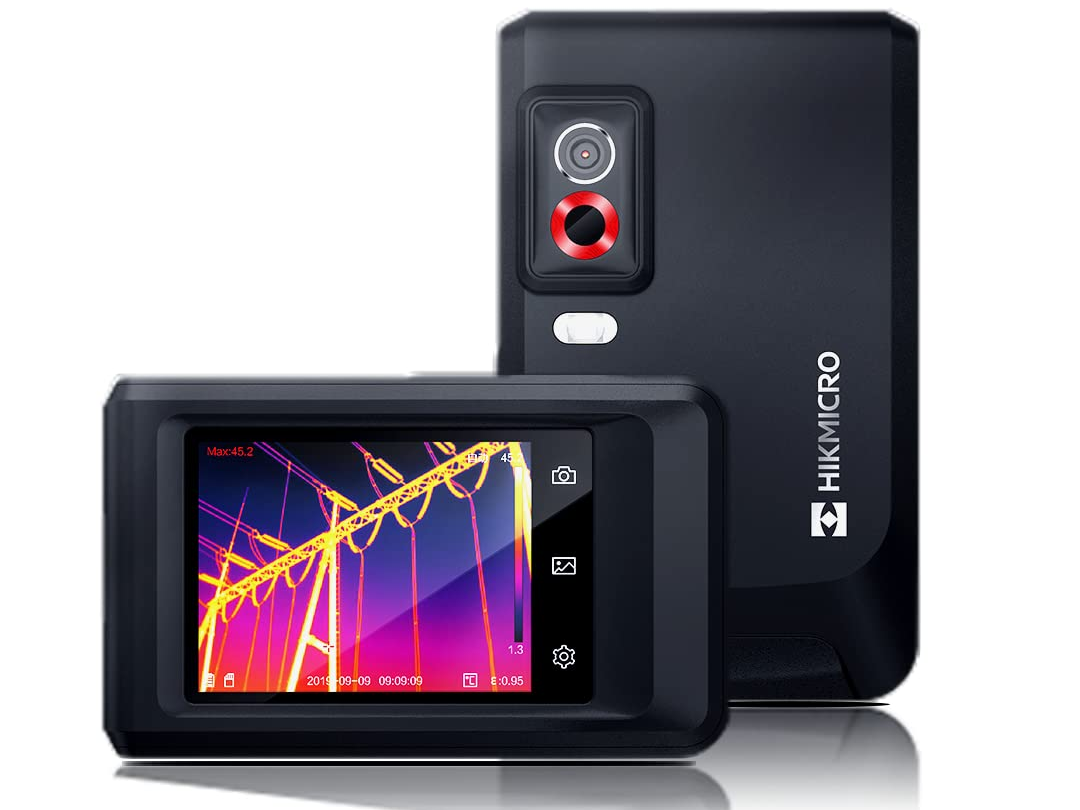
Important features:
- You have amazing high quality results with 256×192 IR resolution and an 8MP camera.
- This camera has a thermal sensitivity of <0.04 °C. Which is standard for most industrial applications.
- Using this device, it is easier to spot subtle heat loss or gain.
- It can connect to mobile devices via built-in Wi-Fi and using the HIKMICRO Viewer App you can watch the live stream on Android or iOS phones and tablets
- It is very easy to view a large target or capture an entire wall in one picture and speeds up your inspection
In a short summary, the HIKMICRO Thermal Imaging Camera (Amazon link) is the best option for pro level users as it has built-in 16 GB eMMC flash storage that can store approx 60,000 standard thermal/visual images or 10 hours of video. And, it allows onboard recording and playback.
5. FLIR E4
Above are all standalone versions of thermal cameras. But we also have scope type thermal cameras as well.
Following is a scope type thermal camera from the famous FLIR. It has a holding hand and is convenient for electrical inspections.

Important features:
- It has a low weight of 0.575 kg and the accessory belt pouch makes it easy to anywhere you go
- It is very reliable even in harsh environments and can withstand a 2 m drop. Which makes it a rugged device.
- It has the 80 × 60 IR Resolution which is the bare minimum. But considering its application it is good.
- It captures and stores thermal images with each pull of the trigger. Radiometric JPEG retains all temperature data within the thermal images
- A focus free lens and simple button navigation to on screen settings make this camera easy to operate
In a short summary, the FLIR E4 (Amazon link) is a compact thermal imaging camera that assists professionals and DIY people alike in spotting hidden electrical, roofing, and plumbing issues, so repairs can be made quickly and affordably.
6. FLIR ONE Pro
The next thermal camera is again from the FLIR brand. It is not a complete standalone camera. It doesn’t have a screen. You connect it to your mobile or tablet. But it does have it internal battery, so it doesn’t drain your phone or tablet battery.
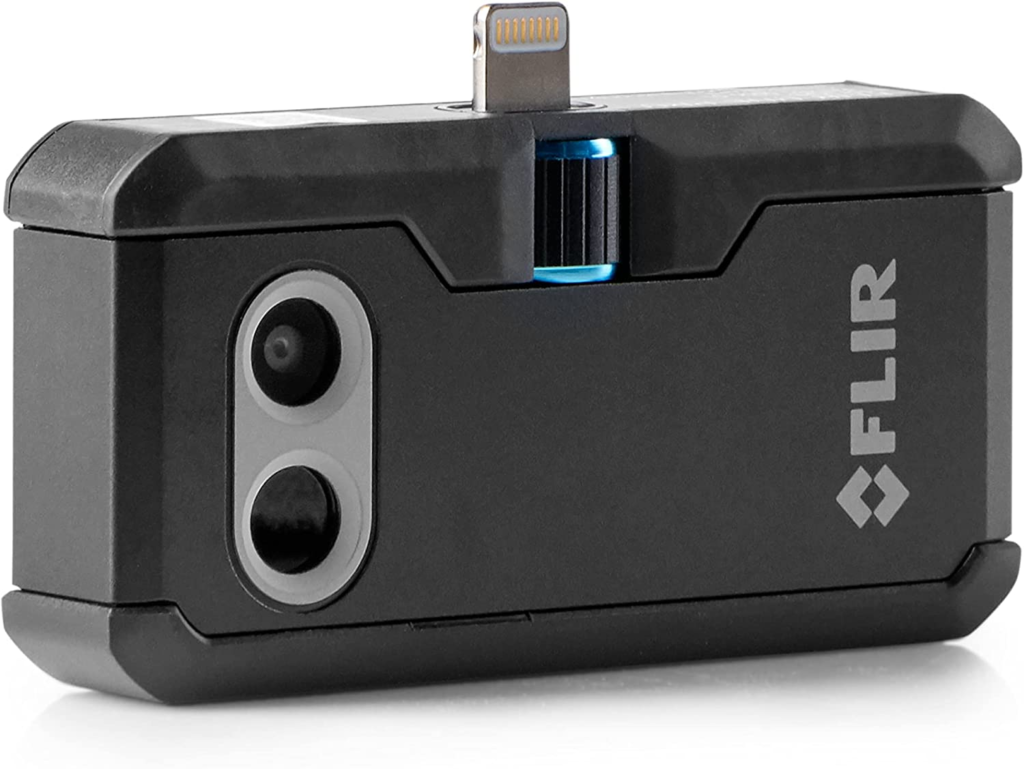
Important features:
- It has the thermal sensitivity of 70 mK which is impressive for such kind of camera
- It can measure temperatures up to 400 C
- It helps you catch potential problems early and reliably diagnose problems
- Simply attach the FLIR one Pro to your iOS phone or tablet, and turn it into a powerful thermal imager
- It can work up to 50 feet (ca. 15 m)
In a short summary, the FLIR One Pro (Amazon link) is best for inspecting Homes, cars, and electrical panels; looking for HVAC problems, or finding water damage, The new FLIR One Pro is a tool No serious professional should be without.
7. Seek Thermal CompactPRO
The last best thermal imaging camera that I have is used with your mobile. It is plug in camera for your mobile that uses your mobile screen for reading.
As it is a plug in small thermal camera that is why it is less expensive than the above we saw. But it is best used for casual purposes or small home or hobby level applications.
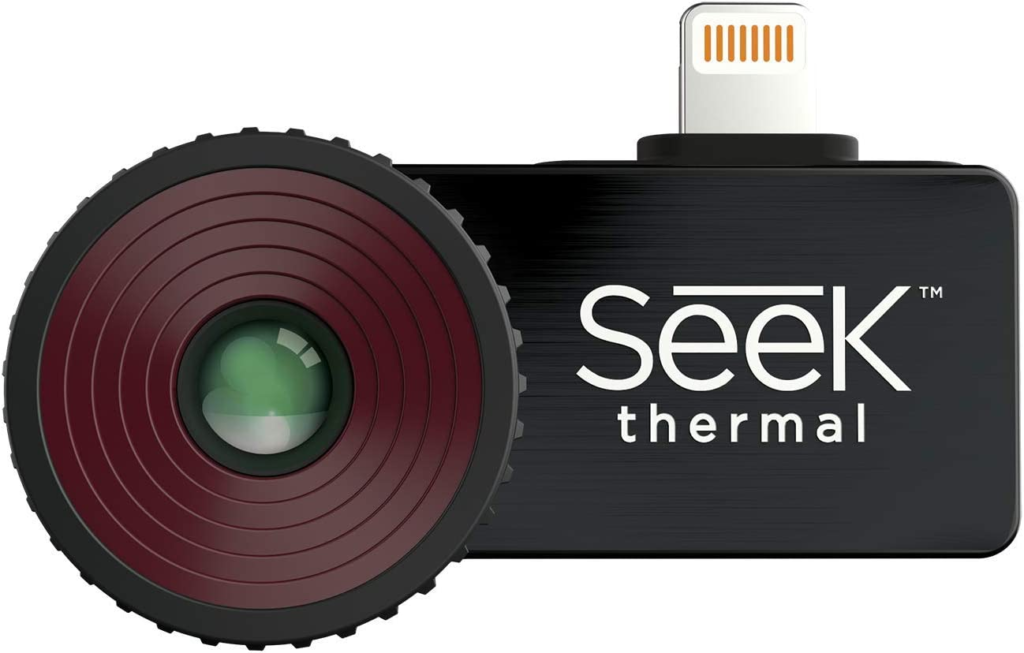
Important features:
- It is high resolution thermal camera with a 320 × 240 thermal sensor
- I believe it is useful to detect energy loss, electrical and mechanical failures, water damage, and hundreds more heat related issues
- It does not require batteries or charging. It takes its power from your phone for its operations
- It has a temperature range of -40F° to 626°F which is impressive
- Refresh rate of < 9 Hz Frame
In a short summary, the CompactPRO (Amazon link) is a great tool for homeowners, engineers, and DIY enthusiasts who are looking for a versatile, high-quality thermal imaging camera that is easy to use and can be easily integrated with their mobile devices.
Conclusion
Thermal cameras are used for a variety of home, electrical, mechanical, and building inspections. Basically, all things radiated infrared radiation (IR) that is invisible to human eyes. A thermal camera has an IR sensor that can detect those radiations.
The more the temperature of the surface the more IR it radiates. Using this phenomenon thermal cameras were designed so that we can detect the heated spot in mechanical, electrical, and building, or even in homes easily.
Now to buy a thermal camera there are a few things you should keep in mind. They are:
- Form factor
- Temperature range
- Sensitivity
- Refresh rate
- Covering area
Using these parameters you should be able to spot a good deal for you.
Alright!
That is it. That is all I have for you about buying the best thermal imaging cameras. I hope I was helpful.
Thank you and have a grateful life.
Other useful posts:
